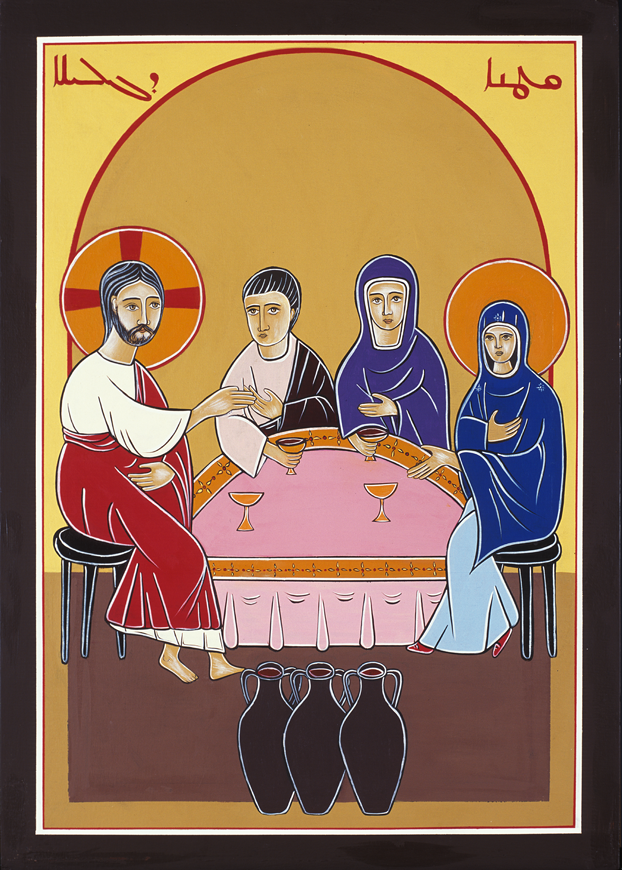
Author: Bishop Antoine-Charbel Tarabay
In the Maronite tradition, Ash Monday prepares us for the fulfillment of Cana Sunday, which falls on the last Sunday and signifies the entrance into the Great Lent.
Behold the fast! On this day it calls to us…
…Through it we inherit life and rejoice with all the saints. (taken from the Incense Hymn of the Liturgy for Wedding Feast at Cana of Galilee)
The Wedding Feast at Cana, a biblical account of joy and feasting, would seem like quite an odd place to begin the Season of Lent, a time of fasting and penance.
Yet in this supposedly odd relationship, we come to find deep theological symbolism filled with Syriac Bridal Theology. Before we begin to understand Cana Sunday, we must first understand the importance of the three preceding weeks in the Maronite Liturgical Calendar.
These are the weeks of Commemoration; of Priests, of the Righteous and Just and the Faithful Departed.
The focus of the Gospels read during the Sundays and their following weeks reveal to the faithful one important concept; sanctity has been achieved by the priests, the righteous and the just and the faithful departed through a focus on the other.
Christ calls us to live our Christian calling with others and towards others, forming a community, the Mystical Body of Christ.
Once we are introduced to this community and shown the path that leads to sanctity, we find ourselves at a communal celebration, a wedding feast that according to the Gospel of John (John 2:1-11), occurs on the ‘third day’.
This should direct the attention of the faithful to the Resurrection, for all feasts and celebrations point us towards the Resurrection, the fulfilment of the Paschal Mystery.
‘On the Third Day’, Christ enters into His ‘time’, performing a miracle that one might dismiss as simple – turning water into wine.
Reading it through Bridal Theology, it becomes significant, as it is only the groom who provides at his wedding.
We are therefore introduced to Christ the True Groom, the New Adam, who in His ‘time’, institutes a New Creation perfected in His Death and Resurrection, symbolically represented by the turning of water into wine, a source of joy and gladness at weddings.
In this New Eden, the woman does not convince man to fall. Rather, Mary beckons Christ to renew and provide joy and happiness for the guests, breathing life into the wedding feast.
How fitting is it that we begin the Season of Lent with a wedding feast and begin Passion Week with another wedding feast.
We read in the concluding paragraph of the Prayer of Forgiveness (Hoosoyo) for the Wedding Feast at Cana “…bless our families and our Lenten journey, that we may reach the harbor of salvation, which is the glorious feast of your Resurrection.”
After forty days of fasting, the faithful find themselves at the Arrival at the Port or Harbour, celebrated on the eve of Hosanna Sunday.
The Gospel read (Mt.25 1-13) is that of the Wise Virgins, who having prepared themselves with enough lamp oil, enter into the wedding feast with the groom.
Who is this groom? It is Christ! And what is this wedding feast?
It is the celebration of the Paschal Mystery, the Resurrection, the banquet of the Eternal Wedding Feast where Christ the victorious Groom provides for His Bride, the Church.
With this in mind, the Weeks of Commemoration become weeks of pedagogy, teaching the faithful through the Gospels read how to walk the path that the priests, the righteous and just and the faithful departed journeyed towards, the Eternal Banquet Feast.
Cana Sunday becomes an eschatological vision of what is yet to come, directing all believers to the fulfilment of the Paschal Mystery.
Yet no one is perfect.
Having learnt what is necessary for salvation in the Weeks of Commemoration, the Maronite faithful, according to our liturgical calendar, enter into the journey of Lent that begins with Ash Monday.
Cana Sunday sets us on the trajectory to fulfilment of eschatological awaiting, while Ash Monday begins our preparation for this union, one that requires cleansing and fasting that is represented by the ashes received ultimately leading to purification of mind, body and soul.
This is achieved through an increase in spiritual wisdom taught to us during the Weeks of Commemoration, allowing us to fill our lamps with enough oil and prepare ourselves for the coming of the Groom who at the end of our journey, will call us to enter into the Eternal Wedding Feast of the Lamb.
+ Antoine-Charbel Tarabay, Bishop of the Maronite Eparchy of Australia, New Zealand and Oceania


